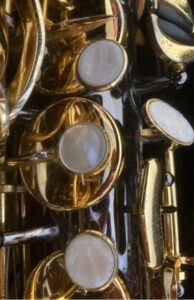
Saxophones are complex instruments with several moving parts. Just like on a car, parts are going to wear out and need to be replaced over time. Reeds will be the most common thing you replace but eventually, the time will come for some pad replacements.
If you’re a player who is using a new sax, then chances are any issues you might be having are reed related and not the pads. Saxophone pads will typically last upwards of 10 years depending on how well you care for the instrument, the type of climate you live in, how often you play, and how often you take it into the shop to get checked out.
If you’re using an older sax then the likelihood of the pads needing to be replaced grows significantly. If you’re able, then the first this I would do after purchasing or receiving a secondhand saxophone is to take it into the shop for a thorough cleaning and tune-up.
Still, even those of us that have been playing for decades might miss some tell-tale signs that a pad just isn’t cutting it anymore. So, here are 9 warning signs that the pads on your saxophone are bad:
- Discoloration
- Pad is Too Hard
- You Don’t Get a Good Key Pop
- Mold
- Pad is Sticky
- Ripping or Tattered
- It’s Not Seated into the Key Properly
- Air is Leaking
- Saxophone Squeaks, Squawks, or Makes Odd Noises
Discoloration
Saxophone pads are typically made from leather-wrapped cardboard or fiberboard. Even if the leather has been tanned, it should have an even “leathery” tone all over the face of the pad.
While discoloration in the leather or tanning process isn’t a sure sign of a bad pad, it can be an early warning sign that your pad is wearing out in one area or has lost its waterproof seal and is starting to hold water under the surface. This will lead to damaging the cardboard part of the pad and you could end up with mold.
Pad Is Too Hard
Saxophone pads are like the old story of the three bears…you don’t want them too hard or too soft, they need to be just right. Now, this is also a matter of taste and the saxophone plays a little into it but in general, you want firm but supple pads.
Too hard and you won’t get a good seal around the tone hole. Too soft and you run the risk of the pad/key sticking a bit. If the pad is extremely soft then you also run the risk of air leaking.
If you have a pad that is too hard your best option, really, is to just replace it with a new one. It’s a quick, inexpensive fix that is almost guaranteed to give you the results you want and get you playing at your peak again.
You can use leather oils, such as old English, but the cost and time required in oiling old pads aren’t really worth it. Besides, the card or fiberboard base that the leather is wrapped on shouldn’t get wet…it’ll warp and decay.
You Don’t Get A Good “Key Pop”

I’m sure everyone has been at the hardware store and popped the top of a PVC pipe, or has done the same to the top of a soda bottle. You get that nice, crisp “pop” sound.
Next time you have your sax outrun down a scale starting at middle C down to low C. Don’t actually play the scale, just run the fingerings down the octave. You get a cool “Blue Man Group” plasticky pop sound.
This is good…this is what you want to hear. The pads are firm enough but still supple enough to mimic your hand hitting the top of a soda bottle. If one of those notes, however, doesn’t resonate as well as the others then you may have a problem.
- Pad isn’t Seated Correctly
- Pad is Glued Unevenly
- The Resonator Could be Loose
- Pad may be Torn
Now, just because the key doesn’t make a full pop sound, this doesn’t mean that the pad is in need of replacing. Remember, the higher notes use smaller keys and tone holes and aren’t going to be as resonant as the lower notes.
This is just another way to help you troubleshoot potential problems with your saxophone. Being a good musician is more than playing the notes…you really want to learn your instrument.
Mold
This one plays into the discoloration topic above and the tattered topic below…since these three usually go together.
Mold thrives in warm, damp place…like the nooks and crannies of your saxophone.
Keypads have the perfect growing conditions for mold and they are one of the last places people…especially new players think to clean and give proper checkups on.
Think of playing the saxophone like swimming…you should wait 30 minutes after you eat. Or, better yet, thoroughly rinse out your mouth before playing, and DO NOT drink sticky, sugary drinks while playing. Blowing this sugary water spit all throughout your sax just created a buffet for germs and mold to grow. And, it should go without saying, don’t chew gum while playing.
Pad Is Sticky
This one follows the last one since sticky pads are usually caused by water buildup in the ring of the pad…sticky drinks only make it worse.
The G# key is notorious on all brands of saxophones for being a key that sticks. Low Eb also gets a mention here, though I’ve been lucky and never really had issues with it on my saxes.
While it’s likely water and sugars that are causing keys to stick it could be other issues as well. The ring of the pad (where the rim of the tone hole sits when the key is closed) could be too deep and tight or slightly too big. This is fairly rare and would be a manufacturing issue. All you could really do here is replace the pad.
One trick I learned pretty early in my saxophone playing was to always keep a few, newer dollar bills in my wallet or sax case or some cigarette paper. Both of these are great for absorbing extra moisture from keypads. Just know that this is a quick fix when you’re in a pinch and pads that keep sticking should be replaced.
Ripping Or Tattered
Since saxophone pads are made out of leather…or synthetic leather…they are prone to tearing, ripping, and tattering. Leather can have thin spots in it or places where the grain is a bit weaker than others, so these spots can wear out more quickly than others.
While a small tear that’s not near the edge of the pad or near the keys with resonators might not be a problem right away, these small snags will turn into holes and quickly make the pad lose any structural integrity. Small holes near the edge of the pad won’t allow a proper seal to form which will cause problems with playing in tune and can create other, odd sounds. More on this below.
It’s Not Seated Into The Key Properly
This might not be a problem with the pad, per se, but more of a problem with the glue that holds the pad into the key. As long as it’s caught quickly enough, you should be able to pop it out, clean the key of any dried on glue, and re-glue and reseat the pad.
If not taken care of quickly enough, the pad can rub against the rim of the tone hole and form weak spots and holes (see above.)

There is also the possibility of having the pad fall out in the middle of practice or, worse yet, in the middle of the performance. If this happens then your playing will come to a full stop…luckily, this is rare unless the pad is really loose. Some players will keep a small bottle of glue in their bags for quick, on-the-spot fixes…though this won’t help much in the middle of a concert.
Just like “kicking the tires” each time your stop for gas, it’s not a bad idea to do a spot check of your saxophone once a month or so. Just a quick check-up and down, touching the pads to see if they jiggle in the key. This is also a good time to make sure the springs and bumper are looking ship-shape too.
If you’re in the middle of playing and hear a clicking sound, then take a break and check the pads…also, check the mother of pearl inlays the main keys have as these will also come unglued and potentially fall out.
Air Is Leaking
Unseated pads or pads with holes in them can cause leaking which will, in turn, greatly impact your practice time. Another big culprit to air leaking is the cork around the neck where the mouthpiece attaches. Cork and pads will usually last you quite a while…with cork being what will usually need replacing more often since you are regularly putting on and taking off your mouthpiece.
Many saxophone players, including me, will also vent air out of the sides of their mouths when playing…this helps control breathing and lets you control when/where you run out of air.
Saxophone Squeaks, Squawks, Or Makes Odd Noises
And finally, be on the lookout…or listen out…for unusual noises. If you’re a new player, unusual noises are going to be the norm, but if you’re at point a where you’re beginning to get a good, clear sound then be cautious if you start squeaking all of a sudden.
I put this one last because I find the biggest culprit to squeaks and unnatural noises is the reed. Always start with the reed when troubleshooting playing problems. it’s the quickest, cheapest, and easiest thing to replace.
But saxophone pads will wear out…luckily they have a lifespan of about 10 years if not longer. This means newer players won’t usually have to worry about it unless they are using a used saxophone.
By the time you have a pad that needs to be replaced, you’ll be experienced enough to know what to look for and possibly be able to fix it yourself.
Final Thoughts
As you develop as a saxophone player you’ll start to find that you (or other saxophonists) become persnickety about their mouthpiece and reed setup. I mean, that’s like a sax player’s fingerprints…no two are identical.
To a lesser extent, the same is true for saxophone pads. Granted, you won’t be changing out your pads nearly as often as you change out your reeds but the day will come when you will have to switch the old ones with new ones.
If you can, try to figure out what brand of pads you are replacing. If you like them, try to find the same ones. If you hated them, steer clear!
